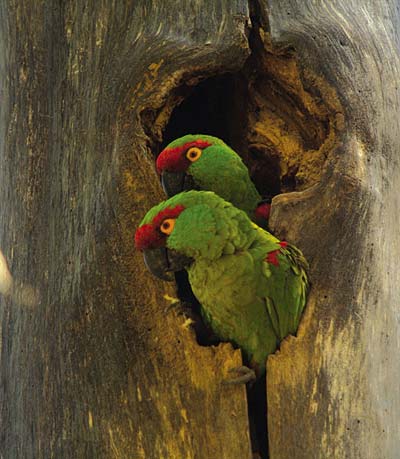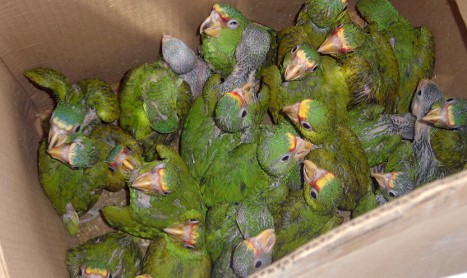Last American Parrot
 Wednesday, September 25, 2013 at 15:05
Wednesday, September 25, 2013 at 15:05
 Wednesday, September 25, 2013 at 15:05
Wednesday, September 25, 2013 at 15:05  Monday, August 20, 2012 at 13:02
Monday, August 20, 2012 at 13:02  Thick-billed Parrot, an endangered species that was extirpated from the United States in the 1930sThe Society for Conservation Biology (SCB) submitted formal comments today to the U.S. Fish and Wildlife Service (FWS) on the draft recovery plan for the Thick-billed Parrot, an endangered species that was extirpated from the United States in the 1930s. The Thick-billed Parrot is now only found in Mexico and continues to decline there, mostly due to the loss of old growth forests in the mountains of the Sierra Madre Occidental.
Thick-billed Parrot, an endangered species that was extirpated from the United States in the 1930sThe Society for Conservation Biology (SCB) submitted formal comments today to the U.S. Fish and Wildlife Service (FWS) on the draft recovery plan for the Thick-billed Parrot, an endangered species that was extirpated from the United States in the 1930s. The Thick-billed Parrot is now only found in Mexico and continues to decline there, mostly due to the loss of old growth forests in the mountains of the Sierra Madre Occidental.
The Endangered Species Act requires the FWS to develop and implement recovery plans for the conservation and survival of endangered species. Each recovery plan is required to include site-specific management actions, objective and measurable criteria to determine when a species is no longer threatened, and estimates of the time and costs to carry out conservation measures to recover the species. While the recovery plan for the Thick-billed Parrot contains detailed information about conservation efforts in Mexico, criteria for recovery within the United States are insufficient and lacking in detail.
 Tuesday, July 10, 2012 at 6:23
Tuesday, July 10, 2012 at 6:23  Thick-billed parrots are equipped with a formidable beak, capable of cracking open pinecones, piñon nuts and acorns, which make up its primary diet. They have also been known to feast on juniper berries and agave nectar.VERDE VALLEY - After weeks spent crossing the most barren and windswept country the Southwest has to offer, the Spanish conquistador Antonio Espejo, his chronicler Diego Perez de Luxon and five soldiers, entered the Verde Valley in May 1583.
Thick-billed parrots are equipped with a formidable beak, capable of cracking open pinecones, piñon nuts and acorns, which make up its primary diet. They have also been known to feast on juniper berries and agave nectar.VERDE VALLEY - After weeks spent crossing the most barren and windswept country the Southwest has to offer, the Spanish conquistador Antonio Espejo, his chronicler Diego Perez de Luxon and five soldiers, entered the Verde Valley in May 1583.
 Tuesday, June 12, 2012 at 10:11
Tuesday, June 12, 2012 at 10:11  Authorities found more than 25 white-fronted parrots squeezed into this cardboard box during a seizure in Chiapas State, Mexico. The vast majority of trafficked parrots die in transit from suffocation, dehydration, stress, and other causes. (Credit: PROFEPA)A trade ban offers hope for a country's native parrots
Authorities found more than 25 white-fronted parrots squeezed into this cardboard box during a seizure in Chiapas State, Mexico. The vast majority of trafficked parrots die in transit from suffocation, dehydration, stress, and other causes. (Credit: PROFEPA)A trade ban offers hope for a country's native parrotsThe international pet trade is likely second only to habitat reduction as the biggest threat facing parrots in the wild. With 22 native parrot species, Mexico is at the forefront of the battle to save its iconic birds from becoming commodities of the pet trade. Early signs suggest it is winning the war.
 Amazona xantholora - Yellow-lored Amazon,
Amazona xantholora - Yellow-lored Amazon,  Ara macao - Scarlet Macaw,
Ara macao - Scarlet Macaw,  Ara militaris - Military Macaw,
Ara militaris - Military Macaw,  Aratinga canicularis - Orange-fronted Parakeet,
Aratinga canicularis - Orange-fronted Parakeet,  Aratinga holochlora - Green Parakeet,
Aratinga holochlora - Green Parakeet,  Aratinga nana - Olive-throated Parakeet,
Aratinga nana - Olive-throated Parakeet,  Aratinga strenua - Pacific Parakeet,
Aratinga strenua - Pacific Parakeet,  Bolborhynchus lineola - Barred Parakeet,
Bolborhynchus lineola - Barred Parakeet,  Brotogeris jugularis - Orange-chinned Parakeet,
Brotogeris jugularis - Orange-chinned Parakeet,  Forpus cyanopygius - Mexican Parrotlet,
Forpus cyanopygius - Mexican Parrotlet,  Pionus senilis - White-crowned Parrot,
Pionus senilis - White-crowned Parrot,  Rhynchopsitta pachyrhyncha - Thick-billed Parrot | in
Rhynchopsitta pachyrhyncha - Thick-billed Parrot | in  Smuggling,
Smuggling,  Wild bird trade
Wild bird trade  Sunday, December 19, 2010 at 10:40
Sunday, December 19, 2010 at 10:40